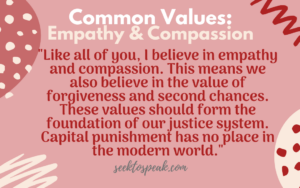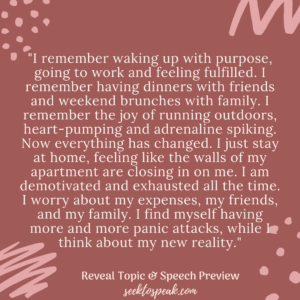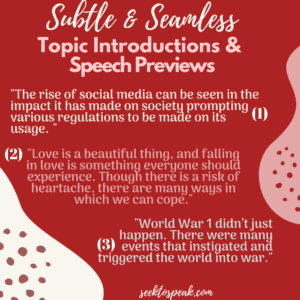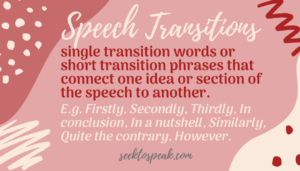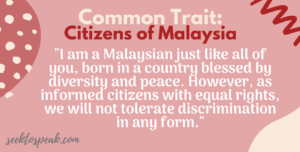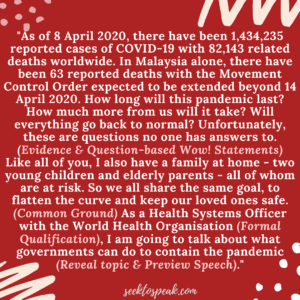Other than WOW-ing your audience, introductions should also preview your speech and establish your credibility, as explained here in the first installment of this series.
Now, imagine starting your speech with the following WOW Statement:
What is the speech about? Mental Health? Death? Unemployment? It’s actually about life under quarantine due to the COVID-19 pandemic. Since the introduction did not make the topic clear, the audience may find the anecdote confusing. Even if you were to explain your topic later, the impact would have been diluted, and you would have lost precious time.
Reveal Topic & Preview Speech
Previewing your speech is a method Aristotle, the father of western philosophy, recognized in his “Triptych” formula for rhetoric. In the modern world, this formula has been coined as the “Triple Tell ’em” method. Firstly, tell ‘em what you are going to tell ‘em. Secondly, tell ‘em. Thirdly, tell ‘em what you just told ‘em. It’s simple but EFFECTIVE.
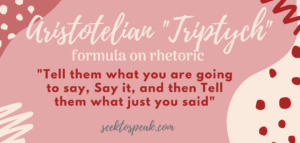
This formula creates a good narrative flow that reminds the audience (constantly) of the points you are going to make, are making, or have made. Speeches are not like articles which you can reread, highlight or annotate. Ideas explained orally need to be repeated to create emphasis and encourage retention. The trick here is to do it subtly so you don’t sound repetitive or dull.
After the WOW Statement, you should reveal your topic and give a preview of your speech, i.e., a summary of your main ideas. Previewing your speech helps prep your listeners to the points you are going to make and allows them to take note of each idea as you transition. This preview will help the audience retain your content as they would be able to summarise and repeat your speech easily. If the audience forgets everything else in your speech, these are the handful of sentences they should remember. You may also reveal the purpose of your speech to give the audience a heads-up of what you hope they will be able to take away.
Speech previews should be creative yet seamless. Take the above WOW Statement as an example,
I remember waking up with purpose, going to work and feeling fulfilled. I remember having dinners with friends and weekend brunches with family. I remember the joy of running outdoors, heart-pumping and adrenaline spiking. Now everything has changed. I just stay at home, feeling like the walls of my apartment are closing in on me. I am demotivated and exhausted all the time. I worry about my expenses, my friends, and my family. I find myself having more and more panic attacks, while I think about my new reality.
You can introduce your topic and preview your speech like this:
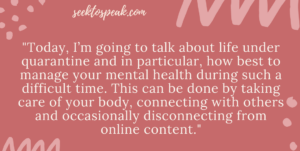
From the above, it is clear that the speech’s theme is about managing mental health under quarantine, and its main ideas are body care, connecting with others, and disconnecting from online content.
While the above preview is clear and concise, it may come off as mechanical or cold, considering the anecdote chosen. Instead, speech previews could be more subtle and seamless:
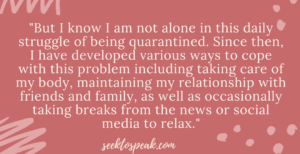
Neither methods are wrong, just different. The first would be great for informative speeches that have the objective of being clear and concise, while the second would be better for personal speeches that aim to motivate or inspire.
After the reveal and preview, you can also add the purpose of your speech. For example,
At the end of this speech, I hope that you are able to incorporate these steps within your daily routine to make life under quarantine not just bearable, but enjoyable!
Other examples of topic introductions and preview of speeches include the following:
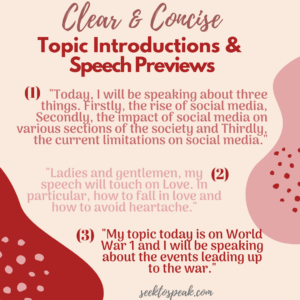
It’s important to include various Speech Transitions between sentences and ideas, making it abundantly clear, the ideas that you are about to be present. Again, these are very straightforward ways to reveal your topic and summarise your points. The more subtle and seamless method could see those statements transformed into:
While the second set of statements have less obvious transitions and explicit cues, it does provide enough information for the audience to dial in. The second method also has the benefit of making the speaker sound more sincere and natural.
Establish Credibility and Goodwill
Before a performer comes on stage or an award recipient is announced, the emcee of an event typically introduces them first. Why is this done?
A speaker jogs onto the stage, dressed well, with a smile on her face, waving to the crowd. You already have a positive impression of her. Why is that?
Well, the answer to both questions is credibility – the quality of being trusted and believed in. Introducing a performer or award recipient beforehand establishes the goodwill of these individuals before they even go on stage. In the second scenario, the speaker’s confidence and professionalism made you more likely to believe what she is about to say.
Credibility is a powerful tool that you can use to make your audience more receptive to your ideas. Establishing your credibility in your introduction creates a great first impression and sets a conducive platform for your audience to be persuaded.
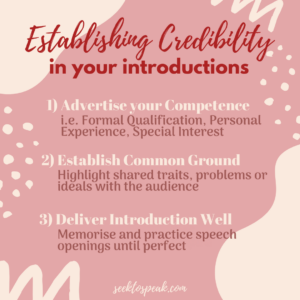
Hence, your introduction should:
1) Advertise your Competence
Within your introduction, make sure to spend some time telling the audience about your qualifications, expertise, or accomplishments related to the subject. So if you are an expert in your field, this would be a simple task.
However, this doesn’t mean that only rocket scientists can talk about rocket science. Competence can come in the form of personal experience or individual interest as well. For example, you do not need to be a Psychiatrist or Therapist to talk about Depression. Maybe depression is something that you have had to go through? Perhaps you know of a friend or family member who is going through the same thing?
You should advertise relevant background information about you so that the audience will see that you are qualified to give the talk. Your listeners should view you as an “expert” to feel like your speech has value. Should they think that you are no more an expert than they are, you are not going to get their attention.
Please keep in mind that this is not an excuse to list down your whole resume or go on a boasting rant. Introductions should not go on indefinitely, so these statements should be short and concise.
Competence can come in the form of formal qualification (i.e., a degree, profession, or certificate), personal experience, or even special interest. Examples of these are as follows:
Formal Qualification
Personal Experience

Special Interest

As can be seen from the above examples, you can reveal your topic and preview your speech before OR after you advertise your competence.
2) Establish Common Ground
The second method to develop Credibility is to establish common ground with your audience. Highlighting commonalities between yourself and the audience help prove your sincerity and trustworthiness to your listeners. This step is especially crucial after you had just spent time advertising your competence, differentiating yourself from them. Your aim here is to be likable, relatable, and sincere.
Authorities advise victims of abductions to humanize themselves to their aggressors. Telling the aggressors about your family, your job, and your life will make the aggressors less likely to harm you. While the audience is not your enemy, the same logic also applies here. When you tell the audience a little a bit about yourself which they can relate to, they are more likely to listen.
Establishing common ground can be done by highlighting shared traits, problems, or values. This commonality allows the audience to better connect with you, giving rise to a sense of kinship. For example,
Common Trait/Attribute Shared
Common Problem/Enemy Faced
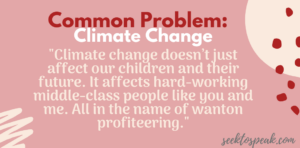
Common Values/Ideals Shared
